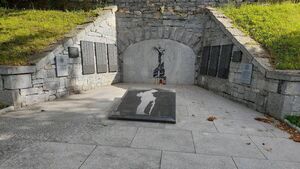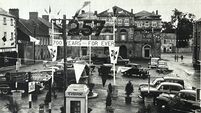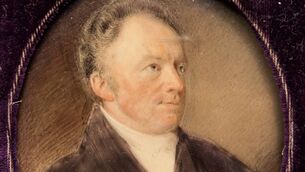Athy cemetery holds many fascinating stories

The war memorial at the old St Michael's Cemetery
ONE of the highlights of the recent Heritage Week lectures here in Athy was the tour of the old St Michael’s Cemetery given by Michael Donovan and Clem Roche.
The cemetery which has been used for centuries surrounds a stone-built church, the foundation date of which is uncertain.
However, we know that the church was referred to in 1297 and the cemetery is still in use today almost seven hundred and thirty years later.
When the small church was built, it was located well away from the Anglo-Norman village of Athy which had developed around the first Woodstock Castle erected on the west side of the River Barrow.
The French-speaking Anglo-Normans were Catholics, as were the native Irish and the settlers’ religious needs were catered for by the Crouched Friars’ monastery of St John’s and the Dominican Friary on the east bank of the River Barrow.
It is believed that the native Irish who provided labour and services for the settlers built their own small church now located in the middle of the old St Michael’s Cemetery.
The tour started at the entrance gate of the cemetery where a lych gate once stood. That was a common feature in all cemeteries of the medieval age and later and consisted of a covered gateway with a wooden bench upon which the corpse was rested while the priest conducted the initial part of the service.
In post-medieval times, the deceased was brought to the cemetery in a parish coffin, and it was at the lych gate that the corpse was removed and buried in a shroud or sheet while the coffin was returned to its base.
A parish coffin was extensively used during the burial of workhouse deceased during the Great Famine.
Just a few yards to the right of St Michael’s cemetery gate is the grave of Paddy Johnson who lived in one of the small cottages at Bothair Bui which were demolished to facilitate the entry of the railway line into Athy.
Paddy who later died had the extraordinary coincidence of being buried in what was once his own back yard.
Michael Donovan, who produced a handsome written account of his cemetery talk, next dealt with the grave of 15-year-old Alexander Henry who died on the 1 October 1849.
His father was John Henry of Glenbawn, Athy who wrote “Athy and its recollections” in 1850. John emigrated to Australia with his wife and their six children a year later but tragically his wife Anne and a young child Andrew died during the journey.
Their son Richard who died in 1929 was the curator and caretaker of the world’s first island sanctuary for birds on Resolution Island on the southwest corner of the southern island of New Zealand.
Next the tour went to Dominican burials, which I must confess I was not previously aware of. The grave slab records that Fr Thomas Cummins, who died October 1788, spent forty years as a Dominican Priest in the town of Athy. Also buried there was Fr James Dunne who died in 1704 allegedly aged 115 years and Fr Michael McMahon, a young Dominican who died aged 29 years.
The departure of the Dominicans from Athy on the 22 November 2015 after almost 750 years in the town was one of the saddest ever losses by the people of Athy.
A grave which was restored some years ago by representatives of the Latvian community in Ireland following a long period of neglect was of Latvian revolutionary, socialist and civil engineer Konrad Peterson.
Peterson fled to Ireland following his part in the Latvian revolt against Russia and soon became involved in Irish national politics. He returned to the Independent Latvia which was subsequently invaded by both Germany and Russia during World War II.
He met C.S. Andrews, chief executive officer of Bord Na Mona, at a conference in Sweden who invited him to take up an appointment with Bord Na Mona at their factory in Kilberry. On retirement, he lived with his daughter who was married to Dr Sean Murphy in Athy.
He died aged 93 years in 1981.
Following an Eye on the Past, I wrote on Konrad some years ago, the Latvian Ambassador contacted me and arranged for a delegation of Latvian officials to come to Athy for a commemorative ceremony at Konrad’s graveside.
In the Presbyterian section of St Michael’s Cemetery are the Campbell and Hannon family graves. Charles Campbell was a Scottish soccer player who was a key player for Queen Park Club and the Scottish National team. He won eight Scottish Cup winner medals with Queen Park and eight international caps with Scotland. At the end of his footballing career, he was elected president of Queen Park club and in 1889 was elected president of the Scottish Football Association.
His parents came to Kilkea in the mid-19th century to take over a farm and Charles later took up ownership of the Campbell farm where he died in 1927. Nearby is the grave of John Alexander Hannon and his wife Martha, who lost two sons John Coulson, known as Ion, and Norman Leslie in the First World War. John was the owner of Prumplestown and Ardreigh.
His son Gordan was ordained a Minister in the Church of Ireland in 1917. Gordan’s wedding arranged for April 1923 in Ballymoney went ahead, despite his father’s death by suicide some days previously in his residence at Ardreigh House.
Gordan’s son Brian was also ordained and finished his clerical career as Bishop of Clogher. His son Neil is the notable singer and songwriter.
Part two of this story in next week’s edition.





